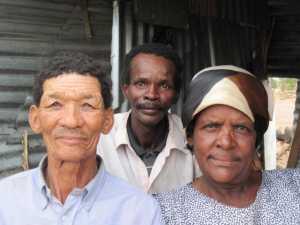04 Dec Natural Selection For Skin Color Varies With Latitude
MedicalReseaerch.com Interview with:

These are South African individuals in a household that exemplify the substantial skin pigmentation variability in the Khomani and Nama populations. Picture taken with consent for publication.
Image by Brenna Henn
Alicia R. Martin PhD, Postdoc
Department of Genetics
Stanford University
Department of Medicine, Massachusetts General Hospital and Harvard Medical School
Stanley Center for Psychiatric Research, Broad Institute, Cambridge, MA and
Brenna M. Henn, Phd, Assistant Professor
Department of Ecology and Evolution
SUNY Stony Brook, NY
MedicalResearch.com: What is the background for this study? What are the main findings?
Response: Skin pigmentation varies more in Africa than in any other continent, and yet genetic studies of this and other traits are massively underrepresented there. Previous Eurasian study biases have instead focused on populations that vary less and have fewer variants contributing to baseline skin color.
In our study, we compiled quantitative skin color measurements from a large, globally diverse set of individuals and populations to show that pigmentation varies more closer to the equator than in high latitude populations. We focused on the ‡Khomani San and Nama populations from South Africa, which diverged early along the modern human lineage from other populations and have lighter skin than equatorial Africans. We showed that skin pigmentation is roughly 100% heritable, but that previously identified genes make up a tiny fraction (~10%) of the variation present in these populations. We identified both known and new genes contributing to this variability.
MedicalResearch.com: What should readers take away from your report?
Response: Our study provides insight into how natural selection for skin color varies as a function of latitude. It has long been hypothesized that directional selection drives pigmentation from dark to light in high latitudes and light to dark closer to the equator, with a few variants of large effect. Our work suggests that stabilizing selection also plays a role especially in populations closer to the equator, with an increasing number of variants of weaker effect influencing skin pigmentation.
Most variants that impact skin color are still unknown, and it is unclear when most known and unknown variants evolved. Predicting skin color and other traits across the breadth of diversity in modern populations is therefore a huge challenge.
MedicalResearch.com: What recommendations do you have for future research as a result of this study?
Response: Genetic studies have been highly Eurocentric to date, but there is an enormous amount of genetic and phenotypic diversity that remains understudied or overlooked globally, especially in Africa. Our understanding of human evolution and genetic risk of different diseases and traits remains incomplete without more inclusive studies and new methods for studying this diversity.
MedicalResearch.com: Thank you for your contribution to the MedicalResearch.com community.
Citation:
An Unexpectedly Complex Architecture for Skin Pigmentation in Africans
Martin AR1, Lin M2, Granka JM3, Myrick JW2, Liu X4, Sockell A5, Atkinson EG2, Werely CJ6, Möller M6, Sandhu MS7, Kingsley DM8, Hoal EG6, Liu X4, Daly MJ9, Feldman MW3, Gignoux CR5, Bustamante CD5, Henn BM10.
Cell. 2017 Nov 30;171(6):1340-1353.e14. doi: 10.1016/j.cell.2017.11.015.
Note: Content is Not intended as medical advice. Please consult your health care provider regarding your specific medical condition and questions.
[wysija_form id=”1″]
Last Updated on December 4, 2017 by Marie Benz MD FAAD
